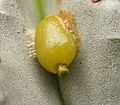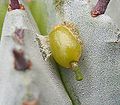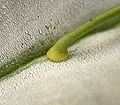Viscum minimum
- View a machine-translated version of the German article.
- Machine translation, like DeepL or Google Translate, is a useful starting point for translations, but translators must revise errors as necessary and confirm that the translation is accurate, rather than simply copy-pasting machine-translated text into the English Wikipedia.
- Consider adding a topic to this template: there are already 1,897 articles in the main category, and specifying
|topic=will aid in categorization. - Do not translate text that appears unreliable or low-quality. If possible, verify the text with references provided in the foreign-language article.
- You must provide copyright attribution in the edit summary accompanying your translation by providing an interlanguage link to the source of your translation. A model attribution edit summary is
Content in this edit is translated from the existing German Wikipedia article at [[:de:Zwergmistel]]; see its history for attribution. - You may also add the template
{{Translated|de|Zwergmistel}}to the talk page. - For more guidance, see Wikipedia:Translation.
| Viscum minimum | |
|---|---|
 | |
| Viscum minimum leaf scales and flowers emerging from the host plant. | |
| Scientific classification | |
| Kingdom: | Plantae |
| Clade: | Tracheophytes |
| Clade: | Angiosperms |
| Clade: | Eudicots |
| Order: | Santalales |
| Family: | Santalaceae |
| Genus: | Viscum |
| Species: | V. minimum |
| Binomial name | |
| Viscum minimum Harv. | |
Viscum minimum is a species of mistletoe in the family Santalaceae. It is a parasitic plant native to South Africa.
Description
In its native habitat Viscum minimum uses two species of succulents, Euphorbia polygona and Euphorbia horrida, as host plants. However, given the opportunity, the plant uses a range of succulents, including cacti, as hosts.
A mature Viscum minimum consists mostly of haustoria within the host plant, but a small stems of less than one millimeter in length with a single whorl of 2-3 scale-like leaves. A single flower, and later a red round fruit with a diameter of 8-9 millimeters, emerges from these stems. The leaves and stems are capable of photosynthesis, making the plant technically a hemiparasite.
The Viscum minimum mitochondrial genome has been sequenced, showing an unusual loss of genes or their functions. [1]
Seed germination
-
 Day 1: The sticky seed has landed on the host plant.
Day 1: The sticky seed has landed on the host plant. -
 Day 4: Germination has commenced.
Day 4: Germination has commenced. -
 Day 10: The shoot emerges from the seed.
Day 10: The shoot emerges from the seed. -
 Day 23: The shoot has made contact with the host plant.
Day 23: The shoot has made contact with the host plant. -
 Day 30: The primary haustorium has developed.
Day 30: The primary haustorium has developed.
Literature
- William Henry Harvey: Flora Capensis 2: 581
- Robert Allen Dyer: Two Rare Parasites on Succulent Species of Euphorbia, Euphorbia Review Vol. I (4): 29-32, 1935
- Thomas Goebel: Viscum minimum Harvey in der Sukkulentensammlung der Stadt Zürich, Kakteen und andere Sukkulenten 29 (1), 1978
- Frank K. Horwood: Two parasites of Euphorbia: Viscum minimum and Hydnora africana, The Euphorbia Journal, Vol 1: 45-48, 1983
References
- ^ Massive gene loss in mistletoe (Viscum, Viscaceae) mitochondria Nature Accessed 5.1.2018

















